Brewing chaga mushroom tea is a simple way to extract the healing compounds of this versatile mushroom, by using hot water extraction. Anyone can learn how to make chaga tea, whether you're at home, or outdoors huddled around a fire!
The chaga mushroom (Inonotus obliquus) is a wild growing fungus that grows on mainly white and yellow birch trees in the Northern Hemisphere. Commonly found throughout Canada, the Northern United States, China, and Russia, chaga has been used for centuries in healing teas and remedies. It can even be used as a fire starter!
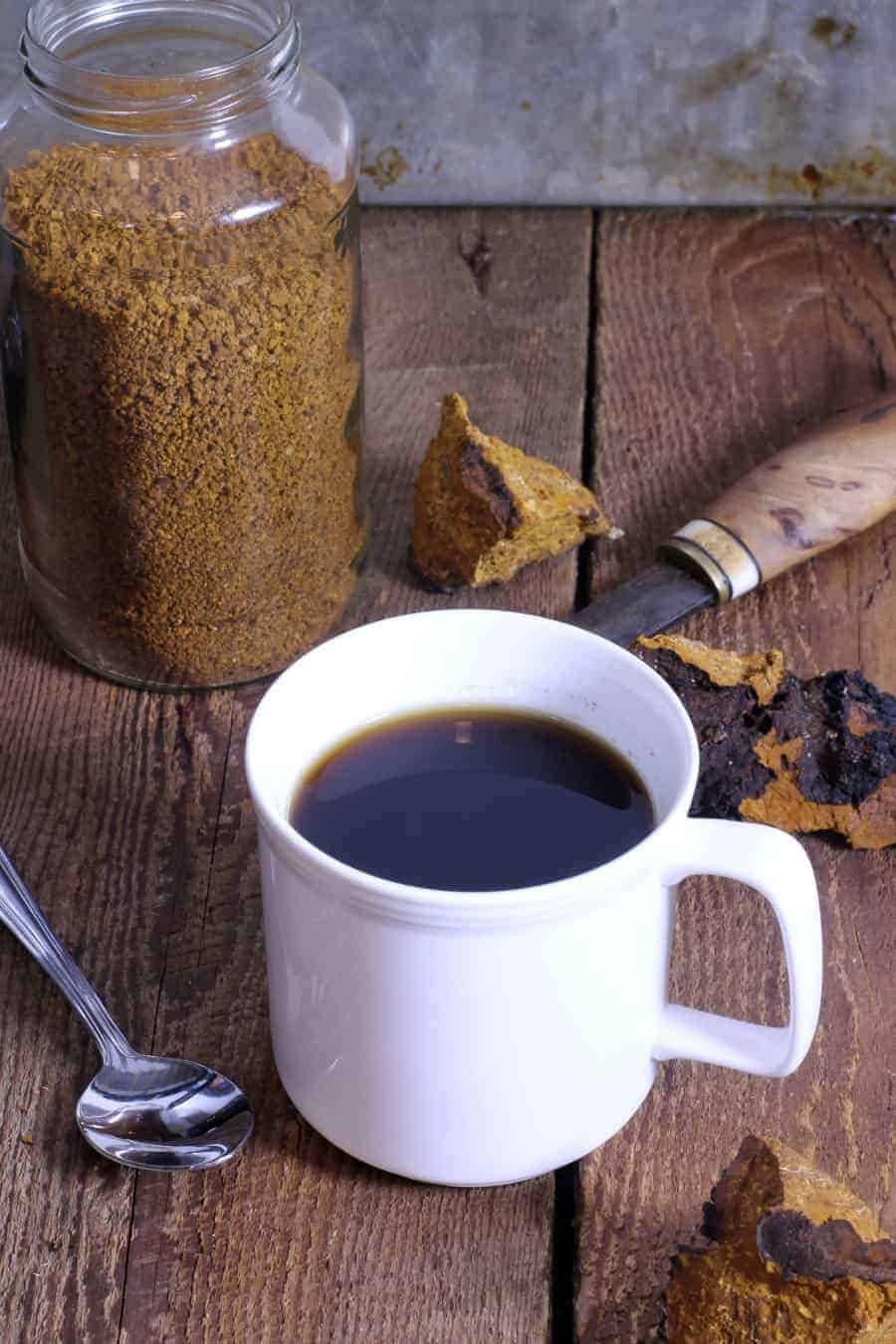
This post contains affiliate links for which I may be compensated if a purchase is made through the links provided. For more information please read my affiliate disclosure.
Why Would I Want To Drink Chaga?
The information contained in this article should not be considered medical advice and should be used for informational purposes only. Nursing or pregnant women should seek the advice of a healthcare practitioner before consuming herbal remedies.
Why would anyone want to consume this funky looking fungus you may be wondering?
Chaga is an ancient herbal remedy filled with various vitamins, minerals, antioxidants, and phytonutrients. Said to help treat everything from tuberculosis, bad circulation, weight-loss, and even to help in the treatment of some cancers due to it's extreme to betulinic acid content. It is easy to see why chaga is the go-to natural tea if you are interested in trying a natural health product.
How effective chaga is at actually curing these diseases is hard to say as there has been very little research into its effects. The potency of the chaga tea or tincture itself would also play a role in how effective a remedy it would be. If you plan on using chaga for medical purposes, always consult a healthcare practitioner first.
Regardless of if chaga is the 'miracle mushroom' it is claimed to be , it is full of beneficial minerals, vitamins, and nutrients, so making chaga tea at home it can't be a bad thing!
Where Can I Find / Buy Chaga?
As mentioned above, chaga can be found growing wild in the forests of North America, Russia, and Europe, and was prized by native cultures for its varied medicinal uses. A parasitic fungus that will eventually kill the host tree, chaga will produce a sterile bulbous black tumour or cankor on the outside of the tree.
The fertile (or fruiting) part of the fungus is almost never visible and grows underneath the bark of the tree once the tree (and the fungus along with it) dies. Look for chaga growing on mature yellow, and silver birch. Similar looking fungi grow on other species of trees but are not true chaga, and as such should not be foraged and consumed.
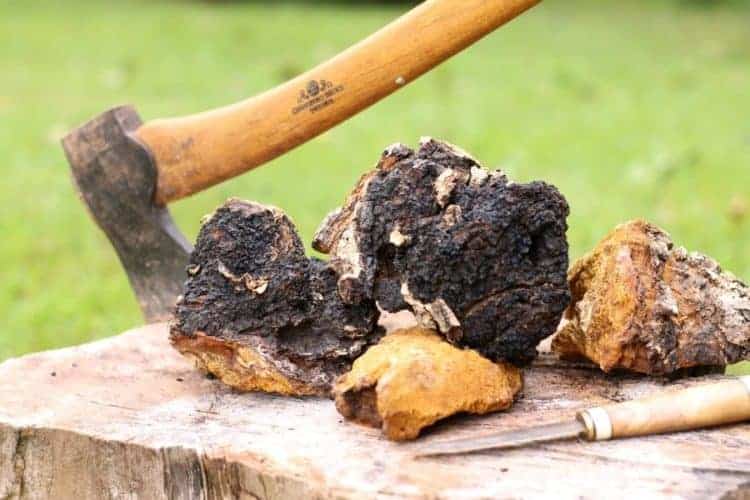
While anyone start harvesting chaga for themselves regardless of the season, it's easiest to forage for chaga in winter, when there are no leaves to obscure your view of the trees. The tell-tale black mushroom is also much more visible against the white backdrop of winter, then during other seasons. Once you find a tree with a large chaga cankor, simply take an axe or small hatchet and carefully cut the fungus off the tree. Chaga smaller then your fist should be left intact to continue growing as, the older the chaga, the more potent it's benefits are believed to be.
As a parasitic fungus, chaga will live along with the tree, for the duration of its life cycle. While the fungus will eventually topple and kill the tree, if the tree isn't harmed in any way, both can live in unison for 20 to 30 years before dying. Always make sure to harvest chaga from living birch trees, as the fungus will die along with the tree once it dies and begin to rot.
If you don't want to forage for your own chaga, dried ready to use chaga can be purchased from various online retailers, though I would highly recommend using a reputable chaga supplier such as Annanda Chaga.
Preparing Chaga For Use In Drinks & Other Recipes
If purchasing chaga, this step is not required and the chaga will be ready for consumption immediately.
If you did forage your own chaga though, you will need to clean and prepare it for use.
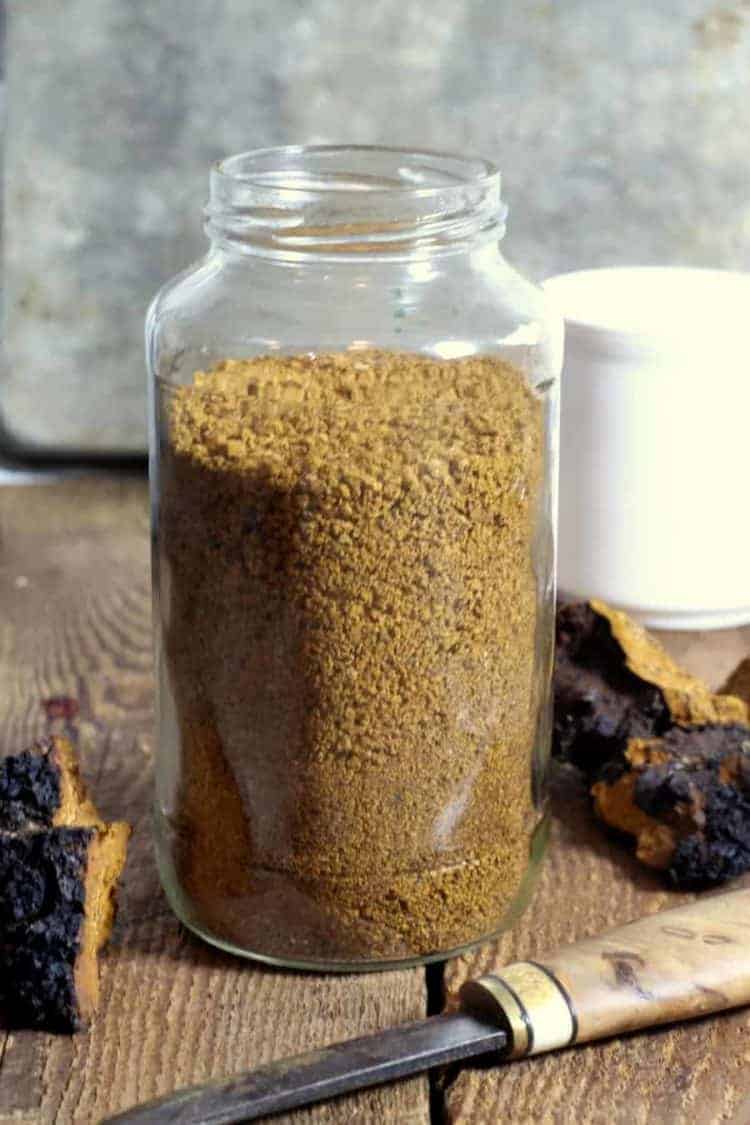
- Start by quickly washing the fungus to remove any dirt or insects that may be hiding in the little crevices. Shake off all the water and break the chaga into fist sized chunks.
- Lay the chaga out in a shaded area and let it dry for two or three days. Once it has had a chance to air dry, bring the chaga indoors and let it continue to dry in a dark cool spot such as your basement or pantry.
- Let the chaga dry in a dark cool location until completely dry, brittle, and light. This should take about a month.
- Once the Chaga is fully dried, process the chaga into varying sizes. Chunked (1 inch size pieces) for use in steeped large batch or slow cooker teas. Coarsly Ground for use in a french press, bodum coffee maker, or tea ball/bags. Finely Ground for use in teas, direct addition to soups, stews, smoothies etc.
- Store the chaga in airtight containers such as mason jars or vacuum sealed bags for long term storage.
How To Make Chaga Tea
Brewing chaga tea at home couldn't be easier. Regardless of which method you choose to follow, the key is low and slow. Especially if you are looking to extract as much of the medicinal properties as possible, it's important not to boil the tea, and instead simmer it (80C or 176F) for a minimum of 15 minutes.
The nutrients inside of chaga are protected by an extremely durable material called chitin. Because of this chaga tea needs to be brewed for extended periods of time, much longer then regular teas to unlock all it's health benefits. The larger the chunks of chaga used the longer the tea needs to be brewed.
Stove Top Tea
If brewing chaga tea on the stove top using a pot, it's best to use larger chunked chaga and not a fine grind, as you can more easily remove the solid pieces prior to drinking the tea. The upside to using larger chunks is that you can re-use the chaga until the tea no longer becomes a dark brown color. Simply pop used chunks of chaga into a small baggy, and pop them in the freezer. Use from frozen to re-use.
Select 4 to 5 individual chaga chunks to add to a pot filled with 4 cups (1 liter) of water.
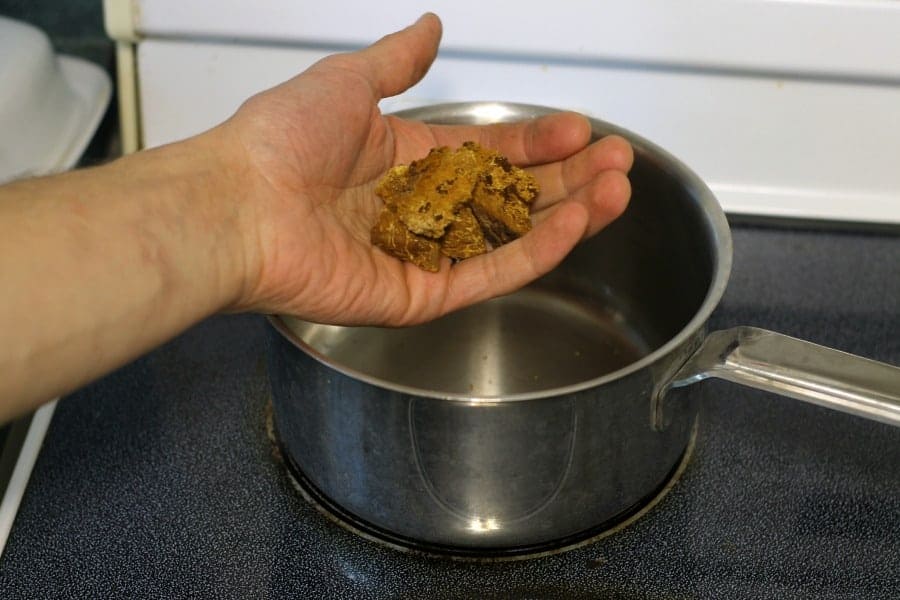
Slowly bring the pot to a simmer, and simmer the tea for a minimum of 15 minutes. If brewing large batches of tea, simmer the pot for 2 to 3 hours.
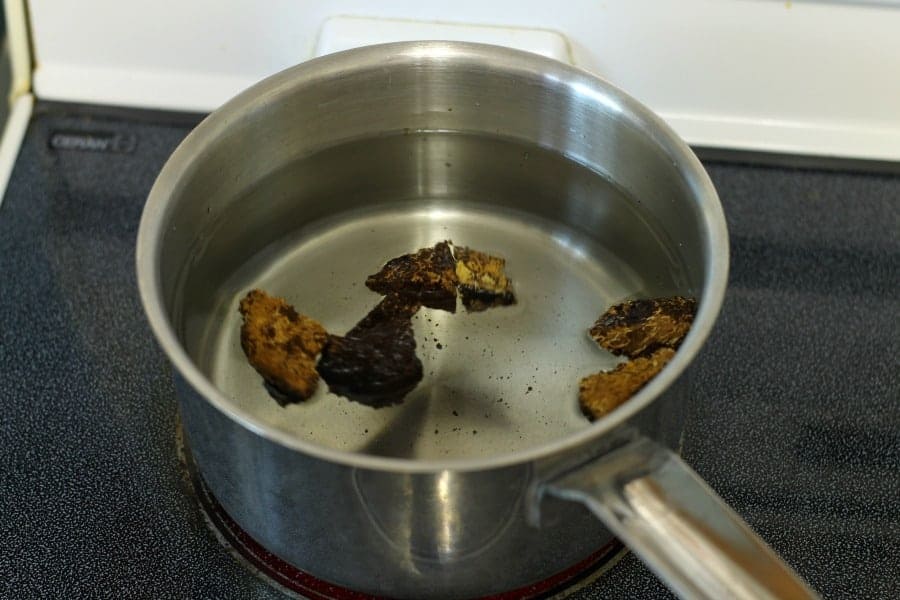
Strain the chaga chunks from the tea, and serve the tea hot immediately. It may be sweetened with honey, maple syrup,. Even milk can be added to the chaga tea to substitute your morning coffee.
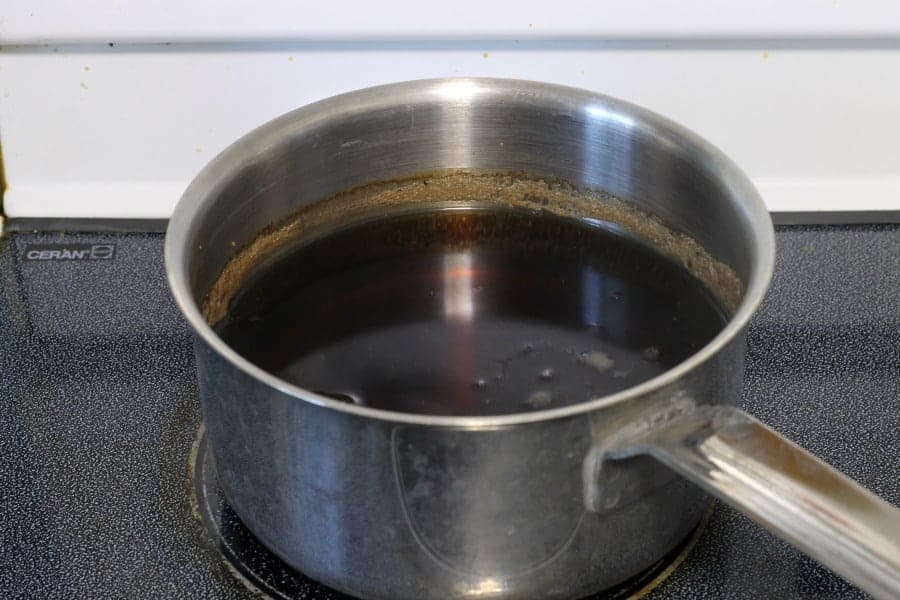
Refrigerate any leftover tea and use within 7 days. The tea may be drank cold (iced) or re-heated.
Individual Cup
You can alternatively brew single cups or small pots of chaga tea by using a finer 'grind' of chaga.
- Add 2 to 3 teaspoons of ground chaga powder per 1 cup (8oz) of water to a tea bag/ball or Bodum style teapot.
- Boil the water, and pour directly over the ground chaga, and into the cup or pot.
- Steep for 10 to 15 minutes, then remove the tea bag/ball, or steeper, and serve the tea hot. The tea may be sweetened with honey, maple syrup,. Even milk can be added to the chaga tea to substitute your morning coffee.
What Does Chaga Tea Taste Like?
A lot of folks may assume incorrectly that since chaga is such a dark, and durable fungus, that it's tea would taste quite strong, bitter, and unpleasant as many natural herbal remedies can be. This is incorrect though, and a good quality chaga tea is actually quite mild, slightly sweet, and even somewhat fruity in flavour.
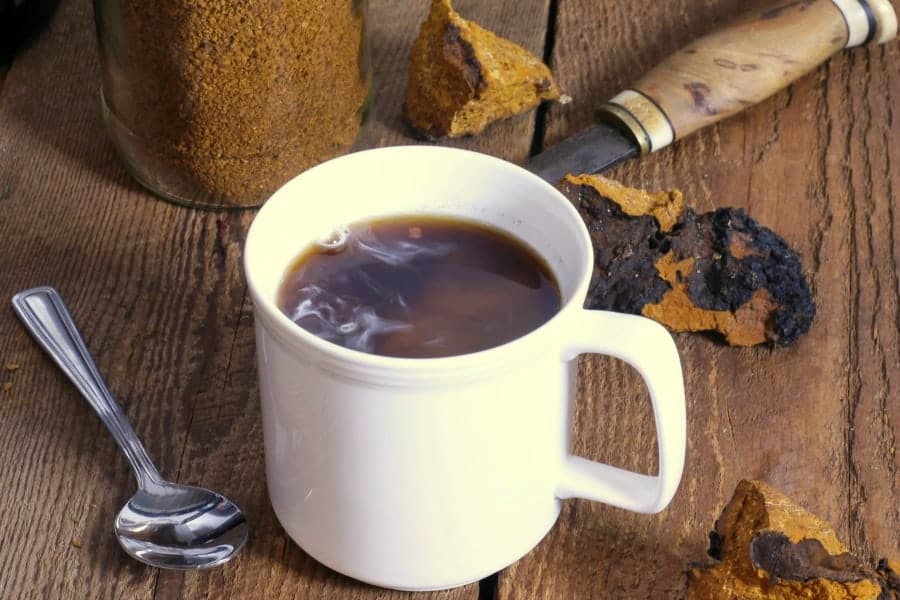
If your chaga tea tastes very bitter, 'dirty' or just plain gross, it is most likely contaminated with mold, of poor quality and should not be further consumed.
Recipe
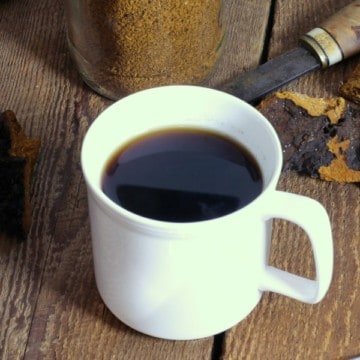
Chaga Tea
Ingredients
Large Batch Stove Top Method
- 3-4 individual chunks Dried Chaga
- 4 cups Water
Small Batch Steep Method
- 2 -3 teaspoon Dried Ground Chaga
- 1 cup Water
Optional
- 1 teaspoon Honey
Instructions
- Select 4 to 5 individual chaga chunks to add to a pot filled with 4 cups (1 litre) of water.
- (Optional): If making a small batch of tea use 3 - 4 teaspoon of ground chaga powder in a tea ball or steeper, in an individual mug or bodum style tea pot.
- Slowly bring the pot to a simmer, and simmer the tea for a minimum of 15 minutes. If brewing large batches of tea, simmer the pot for 2 to 3 hours.
- Strain the chaga chunks from the tea, and serve the tea hot immediately. It may be sweetened with honey, maple syrup,. Even milk can be added to the chaga tea to substitute your morning coffee.
- Refrigerate any leftover tea and use within 7 days. The tea may be drank cold (iced) or re-heated.
Nutrition
Nutrition info is auto-generated. This information is an estimate; if you are on a special diet, please use your own calculations.
Other Uses For Chaga
Fire Starter
One other extremely useful way chaga can be used is as a fire starter or to transport fire on a hike or backwoods excursion. When dry, chaga is very dry and porous. This makes it ideal for use as a fire starter, as chaga has a tendency to smolder very slowly, and won't actually burn with a flame.
- To use chaga as a fire starter, grind dried chaga and use it as you would dry tinder with a steel fire striker.
- To transport an ember, hold the dried chaga to a flame until it starts to smoke and smolder. Wrap the ember in leather then store the chaga ember in a cloth bag. Once ready to use, take out the chaga, and blow on the ember to bring it back to a glowing red. Hold dry grass or wood shavings to the ember to catch a flame.
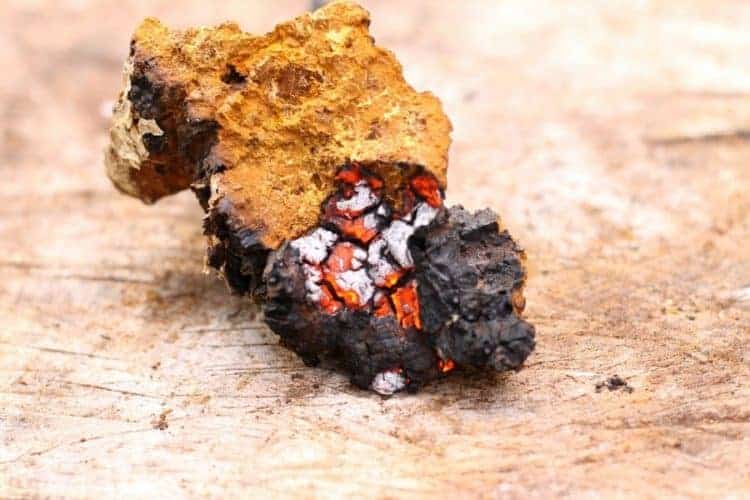
Mosquito Repellent
Another use for chaga us as smudge. In other words, dried chaga can be lit, and left to smolder and smoke much like incense is. The sweet smelling smoke is excellent for keeping flies at bay!
Other Wild Foraged Herbal Teas
Have you ever harvested or used chaga? Take a picture and tag me on Facebook & Instagram: @earthfoodandfire . For more from scratch recipes follow me on Instagram & Pinterest


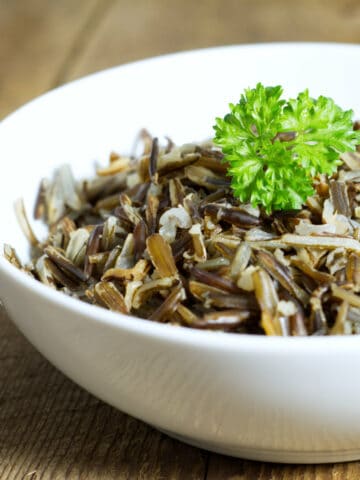
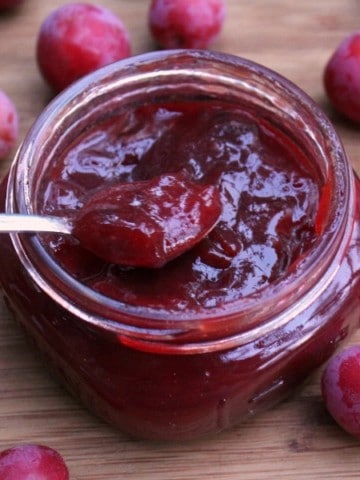
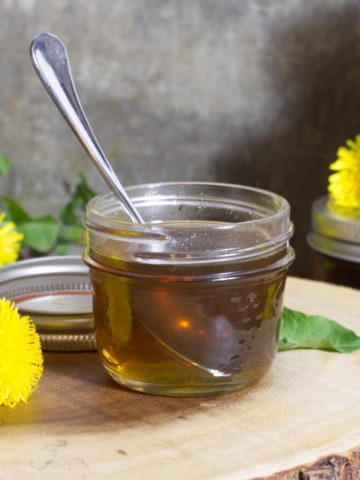
Rose McKinnon
I use one cup of small chaga chunks to 1 gallon of water, simmer for 4 hours, save the chunks and re-use up to 4 times with a little less water each time. Have been doing this for years.
James
thanks for the recipes. they have helped me out for making small batches, eg one cup at a time.
Gail
Hi
I just finished grinding my Chaga in my coffee grinder and maybe went too far? It is like a fine powder. Some of the pieces of Chaga wouldn’t break up. This was from foraging ourselves and it has been drying for almost two months. Not sure now how to use this fine powder?
Chef Markus Mueller
Hi Gail, just use it like normal, you'll simply need a finer strainer to remove the grounds before drinking. An espresso mesh filter may do the trick!
Shecky Calrissian
Good info, but like ALL the sites I searched, WAY TOO CUTIE-PIE. Cripes, first text out of the box is How To Make Chaga Tea At Home, followed by an endless diatribe of anything but "How To Make Chaga Tea At Home" until the freakin' end of the article. Why not put the instructions FIRST and then if anyone is interested, they can read on. Would save us in need of health restoration a lot of stress. Thanks for the info nonetheless.
Chef Markus Mueller
Why not just use the 'Jump to recipe' button at the very top of the post? It's why it is there for those that wish to skip the content 🙂
Belinda
For the ones who like to point out every flaw in the book...there is a jump to recipe box at the very top of the page!!!!
Judy
Hi there,
I use the overnight slow cooker, it turns out great. I have a question about colour of the drink. Is it the darker the more nutrient-wise? Also, what does it mean the organic chaga? And what is the difference between the wild and organic?
Chef Markus Mueller
Hi Judy, I can not comment on whether or not a darker tea is more nutrient dense, as I have no way to actually test for this. That said I would assume the longer you steep the tea, the stronger it will become as more nutrients are leached into the water (up to a point of course). As for organic vs wild, I am not sure. I would guess the organic label is applied to indicate a natural product. Since chaga is not farmed though and is normally foraged from forests, it would all technically be both 'wild' and 'organic' unless someone grew it from spores, or used an artificial means of producing it, which seems unlikely.
Ramsay Drummond-Young
Hi
Thank you for your informative article. I have just started drinking Chaga tea made from chunks I grind up in a blender with water and then heat to make the tea. I very much enjoy it with a dash of honey.
My purpose and hope is the Chaga tea will help with my to way high blood pressure. How much tea is the recommended amount to consume to achieve this without over doing it?
Your guidance would be much appreciated along with any other recommendations to reduce blood pressure.
Chef Markus Mueller
Hi Ramsey, I'm glad you enjoy the chaga tea so much! While it is true there are reported health benefits to consuming chaga, we are not able to provide any kind of recommendation on this front. We only provide the information in the post above for educational purposes and it should not be taken as medical advice in any way. We highly suggest you consult with a licensed medical practitioner for information on managing any health conditions or concerns you may have.
All the best!
Michael O'Flaherty
Great article thanks. One addition: please don't burn your chaga; it is so valuable and you can use alternatives that are easier to fine, such as horse hoof fungus (Fomes fomentatrius, a polypore) or even dried punky birch (since you'll be in a birch-bearing area).
Rick
What is the recommended way to reheat Chaga tea if your making a gallon? I want to keep as much nutrients as possible and I didn’t know if there was one way preferred over another? Thanks
Chef Markus Mueller
Hi Rick, I would simply re-heat the tea in a pot on the stove.
Sharon
Hi
Just wondering what you do with the chaga chunks you boiled to make tea? Can you only used them once?
Chef Markus Mueller
Hi Sharon, you can re-use the chaga chunks to make another batch of tea, but with each use the chaga tea will become weaker. I usually add my used up chaga chunbks to my compost pile after one or two uses.
Doug
I want to know (and please do not answer with a "should") what electric grinder I can use to grind chaga, please?
Chef Markus Mueller
Hi Doug, I have used coffee bean grinders such as this one (affiliate link) or even an electric bullet style blender like a Nutri Bullet (affiliate link). You just need to get the dried Chaga to a ground coffee consistency if you don't have time to steep larger chunks of the mushroom. Hope that helps!
Michael O'Flaherty
you just need to use something like adjustable pliers (e.g., Channel Lock) to break the chaga into smaller pieces before using a coffee grinder
Zach
Quick question - I harvested some chaga a yr ago, and chunked and dried properly, but have been storing the dried chunks in a paper bag, in a dark closet; do you think it is still safe to consume? There wasn't anything visibly wrong with them, nor was there a smell that seemed out of place. I made a small brew (my first one at that), and the tea has a pleasant earthy taste, with just the slightest of bitterness....hopefully all will be ok lol.
Thanks for the great article!
Chef Markus Mueller
Hi Zach, i don't see why it wouldn't be safe to drink. As long as it's fully dried, with no signs of mould or pests getting at it, I would say you are fine!
Noah Smith
There are a lot of different ways to enjoy mushroom. I found much more than what I was looking for. A great site that I have now bookmarked in my internet favourites section. Thank you Chef Markus. Excellent site.
Chef Markus Mueller
You're very welcome Noah. We hope to be adding more mushroom/ foraging related content in the future!
Deborah Smith
Thank you for sharing this one. It is really helpful for me. Your article is very informative. I've found the answers to all my questions about Chaga tea. Credits to the writer of this article.
Joann
left wrong email on last message. Can I brew some tea from fresh Chaga - that is, before it is dried?
Chef Markus Mueller
Hi Joann. I dont see why you couldn't. It would be much like brewing tea with fresh tea leaves.
Daniel Silvan
A search for Chaga tea luckily brought me here. I found much more than what I was looking for. A great site that I have now bookmarked in my internet favourites section. Thank you Chef Markus. Excellent site.
Chef Markus Mueller
That is great Daniel! Glad you like our website. if you have any suggestions for future content, please don't hesitate to let us know!
mathew cullivan
hello great post, my question is how do you know what you are getting, i would hope that you are getting the best chaga mushroom but you never know. there are so many companys jumping on the band wagon which is the best. thanks for your post on brewing..
Chef Markus Mueller
Hey Matthew, Your best bet would be to contact the company directly and get more information from them regarding their source as well as if they have it tested. If you are wary about your source, I would suggest contacting Annanda Chaga, they have their chaga lab tested by a third party to guarantee quality.
Rachel
Do you think Mountain Rose Herbs would be a good source?
Chef Markus Mueller
Hi Rachel, I've never ordered from Mountain Rose Herbs, so I can't really offer any advice on their quality. If you do order some, I'd love to here how they are!
Brad
The best in the west, east, north and south!
Cristina
Hi, can I ask on what type of surface or container should I light the dried chaga chunks?
Chef Markus Mueller
Hi Cristina, It doesn't really matter what type of surface you light the dried chaga on as long as it is fire proof.
Lizzy
I love chaga tea! I never knew that it could be used as mosquito repellant though!! How interesting.